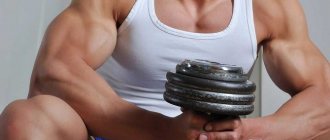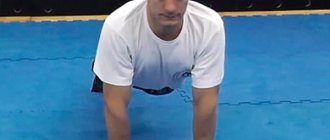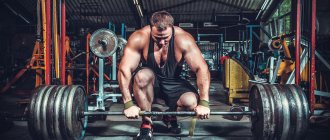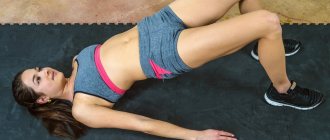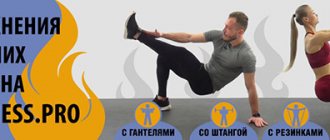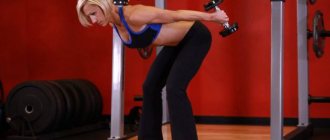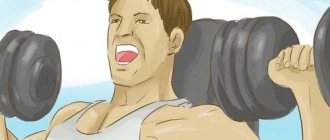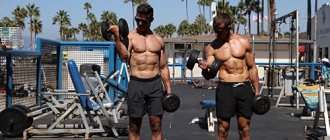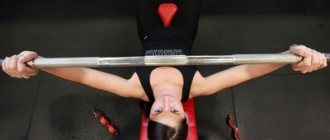Functional training, what is it?
This type of training appeared relatively recently and is designed for students of any gender, age, physiological characteristics of the body and level of fitness.
Training takes place in the gym, accompanied by fast, energetic music and with an experienced fitness instructor. This training differs from other fitness areas in that it imitates familiar and everyday movements, which improves the strength abilities of the muscles.
The training uses special sports equipment, thanks to which movements are made along a free trajectory, and not along a fixed one (free weights, shock absorbers, traction machines, scales).
All this allows the muscles to work in a physiological mode, as in everyday life, helps reduce tension in the joints, is an adequate prevention of injuries (unlike training on conventional exercise equipment) and significantly increases the effectiveness of training.
By performing exercises, you force absolutely all the muscles of the body to work, which are responsible for maintaining balance, stability, as well as the deep muscles of your body.
Classes increase physical fitness - improve flexibility, agility, endurance, strength and speed of the body. Practicing this sport is a direct path to a beautiful and resilient body.
Training for this type of fitness has many exercise options that allow you to create various complexes and lessons.
This sports area is suitable for those who want to lose weight or simply keep their body in shape.
In 2005, D. Sheptukhov proposed 5 principles of “functional training”:
- Do the exercises while standing.
- Free weights are used in the training.
- Basic exercises.
- Speed training.
- Train the movements, not the muscles.
What is the difference between strength training and functional training?
Understanding strength training in areas such as powerlifting and bodybuilding, we emphasize that the goals of functional training and strength training are different.
- With the help of strength training, athletes purposefully “build the body” by pumping up certain muscle groups or specific muscles.
- In functional training, the priority is the harmonious development of muscles and the coordinated work of all muscle groups, increasing strength and endurance, and flexibility of the body.
Accordingly, the “tools” for achieving these goals are also different.
- Functional fitness is a mix of cardio and strength exercises; it involves all muscle groups in a comprehensive manner, including the most difficult to reach.
- Strength training works strictly specific muscle groups or even some muscles in isolation.
Almost all workouts are tailored to suit beginners of varying fitness levels. But a feature of functional training is its wide availability for people of different ages, gender and fitness.
- Functional training is physiological. Multi-joint exercises make the load gentle on ligaments and joints, the load on the spine is low, and the development of stabilizer muscles reduces injuries.
- Strength training is characterized by working “at the limit”, in a state of tension. The technique of performing the exercises must be refined, and the assessment of the workload must be adequate. Otherwise there is a risk of injury.
Contraindications
This type of training is contraindicated for the following persons:
- with heart or lung disease;
- with problems with the spine;
- pregnant and lactating women;
- hypertensive patients;
- having kidney problems.
Before starting training, you should consult your doctor. Sports shouldn't cripple you. Treat training with caution, especially for beginners. If you feel unwell, it is better to stop this exercise and replace it with another.
Ulysses William Junior
Ulisses began making his dream come true as a teenager, working hard day after day in the gym. Today, Ulisses is the top fitness model on the planet with numerous titles.
The bodybuilder strictly monitors nutrition, which helps to maintain excellent shape all year round. Ulisses regularly appears on the covers of famous American and European magazines such as Men's Health, Musclemag, Men's Fitness, REP's and FLEX Magazine.
He is one of my personal favorites.
Read more: Proper nutrition for athletes, menu for bodybuilders, athletes and fighters
Ulysses William Junior is a bodybuilder with one of the best naturally built bodies. I especially admire his arms and abs.
Programs and exercises
This fitness system offers a large number of different exercises and techniques, as well as their variations. However, we can highlight the main (basic) exercises, which we will talk about later.
Bodyweight exercises:
- various squats (on one or two legs, with legs wide apart);
- lifting the torso from a prone position;
- jumping onto a step and then jumping off it;
- Burpee is a CrossFit exercise that combines push-ups from the floor, pulling your legs towards your arms, and jumping up with a clap overhead;
- workout - training with your own weight in the fresh air;
- Do push-ups upside down against the wall, placing emphasis on your hands, and lift your legs up onto the wall. In this position, do push-ups;
- jumping rope in functional training should be done long, trying to rotate the rope 2 times;
- lunges forward or backward and to the side.
Exercises with gymnastic apparatus:
- hanging at a corner with legs raised at 90 degrees;
- pull-ups on gymnastic rings - first raise your arms up to an angle of 90 degrees, sharply straighten your arms up, and then lower yourself to the position of bent elbows;
- push-ups on parallel bars, bend your arms at the elbow to 90 degrees;
- climbing a rope or rope ladder;
- Pull-ups on the horizontal bar (bar).
Speed exercises:
- cross-running, when an athlete must quickly cover a distance from 100 to 1000 meters;
- classes on a rowing machine, reminiscent of oars on a boat. It is necessary to overcome a distance of up to 2000 meters.
Functional training with a load:
- deadlift;
- lifting the barbell from a sitting position;
- squats;
- swing with weights. The kettlebell is taken with both hands, raised above the head and lowered between the legs, then raised up again.
Functional training at THE BASE
One of the advantages of the functional direction is the variety of training. You can work with your own body weight or weights (weights, dumbbells, balls, weight plates, elastic bands, etc.), as well as use additional equipment (moving platforms, special shoes, sling loops).
Come study at THE BASE and pay attention to our top functional training.
CXWORX (LesMills studio)
This is a high-intensity training with free weights and a special rubber shock absorber. During the lesson, the muscles of the shoulder girdle and legs are worked out, coordination is trained, and posture improves.
To learn more
TRX (Exos studio)
TRX loop exercises using your own body weight are performed partially suspended. Loops allow you to fix your arms and legs in different positions, change the trajectory of movement and shift the focus to working different muscles.
To learn more
Fitness training for weight loss
This type of training gives good results in weight loss because the classes are very intense. For those who doubt, I will explain:
- Functional training keeps your heart rate high, which will burn a lot of calories;
- frequent and intense breathing will give a greater flow of oxygen to working muscles;
- simultaneous work of all muscle groups, which also helps burn calories;
- Training duration is from 20 to 60 minutes.
Functional programs for weight loss
The effectiveness of regular sports training is that it helps burn calories, and during prolonged aerobic exercise, it uses accumulated fat as an energy source, that is, it promotes fat burning.
The bonus of functional training is that by burning fat reserves, you simultaneously increase muscle mass. This changes the contour of the body, makes it more toned and attractive, and most importantly, makes it possible to spend more calories at rest. This occurs due to the acceleration of metabolism already in the post-workout time.
Weekly lesson plan for beginners
To achieve results, I recommend exercising at least 3 times a week. If you already have experience, then 4-5 will be enough. In this case, you can train 2 days later.
It is necessary to perform all exercises in 1 approach, going through 3-5 circles, without rest between approaches. We rest for 1-1.5 minutes after completing the first circle and then continue.
Monday
- Squats without additional weight - 15-20 times
- From a lying position, raise your legs - 10-15 times
- Push-ups - 10-15 reps
- Plank - 13-40 seconds
- Jumping rope - 30 sec
Wednesday
- Twisting on the floor - 15-20 times
- Push-ups - 10-15 times
- Lunges on each leg - 10 times
- Elbow plank - 40-50 sec
- Jumping on the platform - 10-15
Friday
- Lifting the pelvis while lying down - 15-20 times
- Plank - 60 sec
- Jump squats - 10-15
- Push-ups - 10-15
- Corner press 10-12 times
More experienced athletes can add here:
- dips;
- pull-ups on the bar;
- squats with dumbbells weighing 10-15 kg;
- burpees;
- exits by force;
- something else.
Functional and specific strength[edit | edit code]
Source: "Training Programs"
, scientific ed.
Author:
Professor, Doctor of Science Tudor Bompa, 2020
Specific strength is often confused with functional strength. The term functional strength is fairly new and refers to exercises performed using a variety of equipment—balls, ABS (plastic) foam tubing, and a proprioceptive platform—that are designed to challenge the environment to increase the involvement of the small and deep stabilizer muscles. [1]. But does anyone really think that athletes won the Olympics, World Championships, and set world records and yet did not work or did not work properly on specific strength before the year 2000?
In fact, specific strength and functional strength are not synonymous. Sport-specific strength training involves replicating the specific form of force required for a chosen sport from a metabolic and neural perspective. The training process is based on exercises that duplicate the action of kinetic chains as part of specific motor skills (including a certain range of joint motion and force vector). Particular attention is paid to the main driving muscles without disturbing the movement pattern that is part of the technique of the sport.
The term functional strength, on the contrary, is not related to the physiological and biomechanical parameters of a specific sports discipline or motor skill, but is more often considered as a designation of a method of training strength, i.e. Functional strength training involves the use of free weights or pulleys, unilateral training, and possibly standing pulleys in multiple planes (exceptions to this definition include propaedeutic exercises and some core development exercises). In other words, when it comes to training specific strength, the most essential starting points are the biomechanical and physiological parameters of the sports discipline. Functional training, on the other hand, is simply defined by the use of exercises with the characteristics listed above.
The statement that the choice of exercise fully determines the degree of functionality of a strength training program is obviously incorrect from a methodological point of view, but it can be said with complete confidence that the best functionalists apply the concept of periodization of strength in planning. Additionally, when defining exercises, functionalists take into account not only biomechanics, but also consider physiology when selecting loading parameters, rather than favoring certain exercises and techniques. However, the question to ask yourself is: To what extent do certain functional training methods meet the goal of achieving the required level of maximum strength for certain strength sports (for example, the single-leg squat while holding a hanging band)? It should be understood that strength periodization is a more complex concept than functional training, and the basis of specific strength is biomechanics and psychology, rather than novelty and variability of exercises or simple imitation of movements from a particular sport.
Zyzz, Aziz Shavershyan
Zyzz, his real name is Aziz Sergeevich Shavershyan, was very thin during his school years. He was inspired to go to the gym by his older brother, who, like Aziz, was an avid World of Warcraft player.
Aziz's transformation continues to be admired by millions of fans around the world even after the young man's death. Azis died suddenly in 2011 after suffering a heart attack. He was 22.
https://youtu.be/XsQGOHX-1kw
Crossfit waters with kettlebells » Sports Murmansk
Everyone knows that kettlebells are a sports equipment that allows athletes to develop muscle strength, as well as strengthen the joints of their body.
Sports weights are made in the form of a metal ball with a special handle designed to be grasped by the athlete’s hand when performing various exercises. Kettlebells can have a wide variety of weights; most often, sports equipment weighing from 4 to 56 kg is used in sports competitions at various levels. A kettlebell weighing 16 kg is called a weight. In kettlebell lifting, competitions are held during which athletes perform a variety of exercises with kettlebells weighing 16, 24 and 32 kg. Featuring a unique handle on top, the kettlebell is unlike any other weightlifting equipment, making it an effective tool for CrossFit training. Kettlebell training allows you to:
- Synchronize the work of all muscle groups of the body. Gaining physical strength occurs at the moment when an athlete adapts to training loads, learning at the subconscious level to activate a wide variety of muscles in the body, which makes it work as a single mechanism. Synchronization develops at the moment when the athlete coordinates his movements with biomechanics, otherwise control over the apparatus is simply impossible, because the center of gravity of the weight is located outside the handle.
- Burn calories unclaimed by the body, which, as a rule, lead to the appearance of unwanted fat deposits. Kettlebell training imposes a significant metabolic cost. Research shows that during a workout using a kettlebell, an athlete burns about 20 calories in one minute, which is approximately 600 calories in half an hour!
- Achieve a high level of strength and energy endurance. During training, the athlete uses his muscles, providing increased oxygen supply to the tissues. Thus, the degree of anaerobic endurance increases and the degree of oxygen absorption increases.
- Perform injury prevention. A kettlebell, unlike dumbbells, provides the athlete with the ability to turn the apparatus in any direction with a simple movement of the hand. This reduces the risk of placing joints in a traumatic position.
- Improve stretching. The kettlebell allows you to perform exercises that are impossible to perform with dumbbells. Consequently, the CrossFit athlete has the opportunity to expand the range of possible movements.
- Diversify your training options. The training program can be changed almost indefinitely, using only different options for gripping the projectile. This allows the athlete to set more and more new types of load on his muscles.
- Develop core strength. During kettlebell training, the athlete engages the core in every exercise performed. Each athlete, while maintaining control over the apparatus, uses the muscles of the arms, abdominals, back and hips, and this requires well-developed coordination of movements.
All these characteristics of the kettlebell allow it to be used quite successfully when performing strength training according to the CrossFit program. Let's look at a few basic exercises with kettlebells that can effectively target a wide variety of muscle groups. This complex can be successfully used during training by both experienced athletes and beginners.
Complex for beginners
The complex for beginners who are just starting to master the CrossFit technique consists of the following exercises:
- Throwing a weight followed by a push. The exercise should be performed in 3 approaches, each of which contains 15-20 repetitions.
- Kettlebell row using one arm. Performing this exercise involves the athlete performing 3 sets of 15-20 repetitions.
- Alternating kettlebell press from a lying position. This exercise should be performed in 3 sets containing 15-20 repetitions.
- Squats with a kettlebell placed in the chest area. This exercise, like the previous ones, should be performed in 3 sets of 15-20 repetitions each.
- Kettlebell swings. For this exercise to be effective, you should perform 3 sets containing 15-20 repetitions.
To perform an exercise called “throwing a weight with a subsequent push,” you need to give your back a straight position and subsequently maintain it. The upper part of the body should be slightly moved forward, performing a slight tilt at the hip joint. Squatting slightly, you need to quickly lift the weight off the floor, straightening your knees, ankles and hips. The back, at the same time, should not change its straight position, the elbows should be kept outward from the weights, and the shoulders should be located directly above the weight. After the first half of the weight's upward path has been completed, you need to squat down slightly, then straighten your legs with an explosive movement while simultaneously throwing the weight over your head with your hands. After completing the full movement, you should return to the starting position and repeat all movements again.
Kettlebell row using one arm. In the starting position, you need to place your feet shoulder-width apart, bend your knees slightly, and slightly tilt your body forward, using the hip joint for this. During the entire exercise, the back should only be in a straight position, the head should look forward. One of the hands holds a weight, the other should rest on some object, for example, it could be a low table or stool. Before starting the movement, make sure that the hand working with the weight is strictly perpendicular to the floor. Perform kettlebell rows to the lower abdomen, while keeping your elbows close to your body. Please note that at the very top of the kettlebell movement, your shoulder blades should be drawn towards each other. Upon reaching the highest point, you must return to the starting position and repeat the movement a predetermined number of times.
Alternating kettlebell press from a lying position. This exercise is not difficult to perform. The athlete should lie on the floor and perform a kettlebell press, alternating hands. In bodybuilding, a similar exercise is called the “barbell/dumbbell bench press.”
Squats with a kettlebell placed in the chest area. To perform this exercise, you need to bend towards the floor, keeping your back straight, pick up a kettlebell and hold it in front of you at chest level. Feet are shoulder width apart. Bending your knees and hips, you need to start doing squats. It is necessary to ensure that during the squat the upper part of the athlete’s body is tilted forward by 5?. After a full squat is completed, you should return to the starting position and repeat the movement.
Kettlebell swings. To perform this exercise, hold a kettlebell between your legs with one hand. In this case, the body should be tilted forward. The back should remain straight throughout the entire exercise. The weight held in the hand must first be swung towards the buttocks, and then with a sharp movement of the body, raise it to chest level, keeping the arms straight. The exercise should be repeated a certain number of times, in accordance with the training program.
A set of exercises with a kettlebell for girls
To complete this complex, girls or women will need only 20 minutes a day. A daily twenty-minute workout will allow the fair sex to become the owners of a slim figure and maintain their body in excellent physical shape. The complex consists of four exercises:
- Squatting and then pushing the weight out. The exercise should be performed in 3 sets, each of which is 3 repetitions.
- Side lunges. You need to do 10 lunges in each direction.
- Kettlebell overhead press. The exercise must be repeated 8 times with each hand.
- Lateral row of kettlebells from a lying position in support. Sufficient effectiveness is achieved with 8 repetitions.
CrossFit for girls. Squatting and then pushing the weight out. To perform this exercise, place your feet shoulder-width apart, pick up a kettlebell and hold it at shoulder level, and squat in a half-squat position. Next, from this position you need to push the weight up so that it is above your head while straightening your legs. Then, the weight must be transferred to the other hand and the exercise repeated.
Side lunge. During this exercise, the muscles of the biceps, back of the thigh and buttocks are worked out. When performing a side lunge, you need to stand up straight, take a kettlebell in your hand and hold it at your right shoulder. Lunge to the left, moving the projectile under the left knee during the movement. Grab the weight under your knee with your right hand. Next, you need to return to the starting position, in which the weight will be held with your left hand in the left shoulder area. Perform a similar movement to the right side and grab the weight with your right hand. Repeat 10 lunges on each side without resting.
Kettlebell overhead press. This exercise can be called a classic work with a projectile, during which the triceps, shoulders, buttocks and thighs are worked out. The starting position is a vertical stance, with the legs in a slightly bent position shoulder-width apart. The weight should be taken in the right hand and placed in the area of the right shoulder. With a quick movement, straighten your legs and simultaneously push the weight over your head. At the top point, you need to fix the straightened arm for about 2 seconds, and then return to the starting position. Repeat the exercise for your left hand. Perform the required number of repetitions.
Lateral row of kettlebells from a lying position in support. This exercise allows you to effectively work the muscles of the arms, legs, chest, back and abdominals. The starting position is a lying position, while the weight should be in one of the supporting hands. From this position, you should lift the weight up, turning the body and leaving the supporting hand in place. Return to starting position. Change hands and repeat the exercise. Perform 8 repetitions in each direction.
As you can see, there is nothing difficult for physically prepared girls in this complex. For unprepared girls, this complex is useful in that it will allow them to acquire the appropriate sports form and gain an attractive figure. At the same time, you will have to spend only 20 minutes a day to perform the exercises of this complex.
Currently, a wide variety of methods have been developed for training using kettlebells in the CrossFit program. There are programs for preparing athletes who take part in strength martial arts, programs for trained and experienced athletes, as well as programs for beginners. This variety allows the athlete to choose the course that suits him and engage in CrossFit in order to improve his physical fitness, as well as to gain good health.
sport-51.ru
Main achievements
Unfortunately, although Markus Ruhl took first places, he did so in very few places, despite his athletic performance. There has always been huge competition in this sport. Despite this, he was always a serious competitor for other athletes, as he was always as prepared as possible for any competition at the highest level. There were no flaws in his body, either in symmetry or proportions. 2002 was the most successful year for Markus Ruhl, as this year he achieved his first victory in the Pro Division. It was the Toronto/Montreal Pro tournament. The competitors at this tournament were more than serious: Daxter Jackson, Marcus Rule himself, the huge Orville Burke and others. In 2002, at the Night of Champions tournament, Marcus won his second victory, since then he had practically no competitors. This was his last victory in the competition, after which he was second, third, fourth, etc. several times. Markus Ruhl appeared at Mr. Olympia in 1999, but did not even make it into the top 10.
At the next Olympia he took 7th place. At the 2001 Olympia, he showed only 14th result, which indicated his poor athletic shape. In 2004, he managed to take 5th place at the Olympia, losing 4th place to Daxter Jackson. In 2009, he conquered this tournament for the last time and took a disastrous 15th place.
MONSTERS DO EXIST! The incredible Markus Ruehl.
Chapter Four: Precision Training, Where Closed Eyes Are the Main Trend
View this post on Instagram
Posted by @TonyFergusonxt (@tonyfergusonxt) Jan 14, 2020 at 12:20 pm PST
View this post on Instagram
Posted by @TonyFergusonxt (@tonyfergusonxt) Sep 19, 2020 at 7:38 am PDT
View this post on Instagram
Posted by @TonyFergusonxt (@tonyfergusonxt) Sep 25, 2020 at 5:18 am PDT
View this post on Instagram
Posted by @TonyFergusonxt (@tonyfergusonxt) Jan 9, 2020 at 12:23 pm PST

